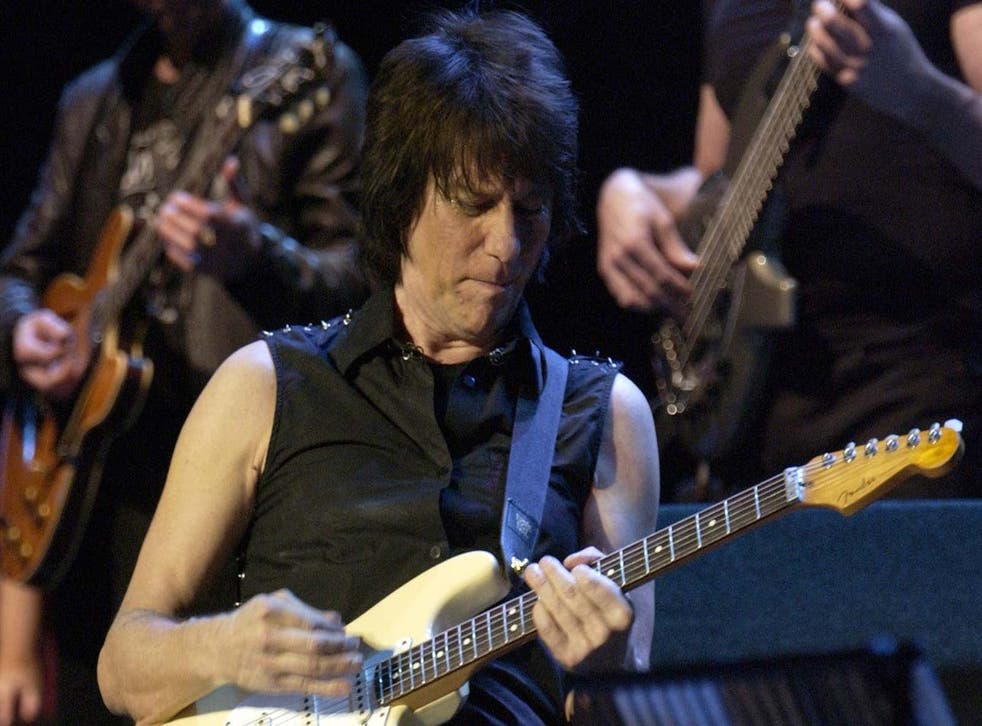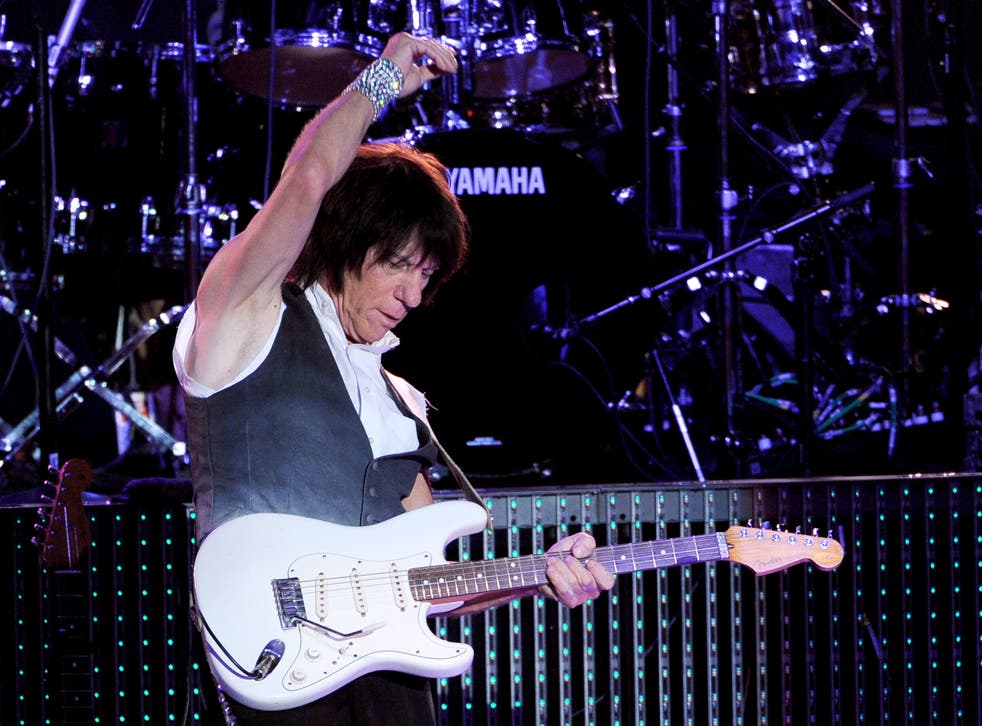THE INDEPENDENT / Mark Beaumont
Within hours of the news of his death, tributes to Jeff Beck from the guitar greats rang out like a 21-string salute. “Jeff could channel music from the ethereal… his technique unique, his imaginations apparently limitless,” said Jimmy Page of this “six-string warrior” and “the spell he could weave around our mortal emotions”. Jeff Beck “was punk rock before punk existed,” declared The Edge. “The Salvador Dali of the guitar,” said Aerosmith’s Joe Perry; “an infinite source of joy,” claimed Stevie Van Zandt; an innovator, pioneer and profound influence, stated Dave Gilmour, Steve Hackett, Johnny Marr and Joe Satriani. The phrase “guitarist’s guitarist”, which could have been coined for Beck, had never felt more apposite.
But while the epithet honours Beck’s groundbreaking virtuoso skills – the liquid lines, ricochet riffs, mystical tones, feedback experiments and innovative techniques that stunned his fans and contemporaries – it underplays his significance and import in the course of rock’n’roll. The roots of psychedelia, heavy metal and jazz fusion, as well as the early influence of eastern music on the west, can all be traced back to Beck’s fingers (insured for £7m). And a man perhaps best known to the wedding conga public for his 1967 hit “Hi Ho Silver Lining” is better remembered as a revered rock Zelig.
Beyond his celebrated work with The Yardbirds and the Jeff Beck Group, he played a pivotal role in the early careers of Rod Stewart, Ronnie Wood and others, almost joined The Rolling Stones and Pink Floyd and could be found adding his quicksilver touch at key moments through the decades. He was onstage with David Bowie playing “The Jean Genie” in 1973. That’s him on Stevie Wonder’s 1972 Talking Book album (for which he reportedly inspired the drum groove for “Superstition”), and on Tina Turner’s “Private Dancer”, Kate Bush’s The Red Shoes (1993) and Roger Waters’ Amused to Death (1992). The canyon-strafing solo of Jon Bon Jovi’s “Blaze Of Glory” is his, and there he is rehearsing with Guns ‘N Roses for a 1992 Paris show around their Use Your Illusion albums. In recent decades, he’s shared stages with Gilmour, Metallica and Brian Wilson and been spotted on albums with Morrissey, The Pretenders, Ozzy Osbourne, and Johnny Depp on their recent collaboration
Robert Plant sums up his go-to guitar god appeal. “Jeff always appeared timeless, ever-evolving,” he tells The Independent. “He embraced project after project with limitless energy and enthusiasm… He cooked up magic through all the passing eras, always up for the next, unknown, unlikely collision, back in time to homage Cliff Gallup, forward to Johnny Depp.”
Recommended
- Jeff Beck death: Legendary rock guitarist dies aged 78
- The 10 new music acts to watch in 2023
- ‘I can’t look away from it’: Ezra Furman on Lou Reed’s ‘menacing and inviting’ Transformer
In the 1960s, indeed, Beck was a backroom beacon of innovation and forward motion. A childhood friend of Jimmy Page (both learned their craft by competing to impress the other with their rockabilly skills), he followed Page into the undergrowth of Sixties guitar exploration. While playing with Screaming Lord Sutch, The Nightshift, The Rumbles, and The Tridents, he became part of a coterie of dazzling underground guitarists and session players, all pushing what can be done with the instrument, and with blues rock and R&B. Intent on making “all the weirdest noises I could”, Beck was obsessed with the possibilities of the new technologies becoming available in rock music, but hemmed in by their limitations too. “It was [a frustrating] period of my life,” he’d say. “The electronic equipment just wasn’t up to the sounds I had in my head.”
Nonetheless, when he – somewhat bravely – replaced Eric Clapton as guitarist in The Yardbirds in 1965, he set about revolutionising their sound, enhancing their fiery blues homages with hit-making sonic adventure. At Beck’s hands, fuzz and feedback arrived, and an exotic eastern influence that played a significant part in ushering in psychedelia and opening western ears to global sounds. Beck made his guitar sound like a sitar on his first Yardbirds single “Heart Full of Soul” months before “Norwegian Wood (This Bird Has Flown)”.
Meanwhile, onstage, he’d wrench new noises from every inch and corner of his Stratocaster – tapping and bending Mixolydian runs or melding notes into exotic tones with the whammy bar. The subtle expertise of his playing created what music historian Charles Mueller described as a “vocal-like nuance”, which “re-humanises the guitar”, and his prowess blew minds across his generation.

“When I was 16 years old, The Spiders, who became the original Alice Cooper band, opened for the Yardbirds,” says Alice Cooper. “That night I experienced the greatest guitar player I had ever heard.” “He surfaced in an extraordinary time,” says Plant. “He took his place side by side with the virtuosos of the period. The scene was on fire [and] he introduced a cool template moving from Yardbird to ‘Bolero’ to Truth.”
Plant refers to one of Beck’s most pivotal developments, and one to which many of the Seventies hard rock acts owe a great debt. Beck’s career might have suffered from his wayward lone-wolf attitude and formidable reputation – having been sacked by The Yardbirds after their most successful 20 months for repeated absenteeism, he’d later turn down a spot in The Rolling Stones, while Pink Floyd were too scared to ask him to replace Syd Barrett in 1967. But it was arguably his 1966 side-project recording of “Beck’s Bolero”, an instrumental rock epic inspired by Ravel, which instigated the heavy metal movement. Recording the track with Page, John Paul Jones, Nicky Hopkins and Keith Moon, who were all interested in playing together some more, Beck very nearly started Led Zeppelin.

Instead, the track emerged as the B-side to Beck’s first solo single “Hi Ho Silver Lining”, and became the cornerstone of 1968’s Truth, the blues rock and proto-metal debut album from The Jeff Beck Group (featuring Ronnie Wood on bass and the little-known Rod Stewart on vocals). Stewart was “the perfect foil,” says Plant, “plenty of sparks, great results”. Soon after, Led Zeppelin themselves took their interpretation of the hard rock enormity of the “Beck’s Bolero” sessions and ran with it to globe-straddling, multi-platinum success. But Beck was already on to new things. Further Jeff Beck Group albums would lean into funk, soul and jazz, and by his 1975 solo album Blow by Blow he was turning his technical brilliance loose in its natural habitat of jazz fusion. The record was his biggest hit, going platinum in America, although the intricacy and precision of the form would play on Beck’s fastidious nature. Producer George Martin recalled Beck phoning him, months after the sessions, asking to re-record a solo on the record: “I’m sorry Jeff,” the production legend replied, “the record is in the shops”
As he moved on to tackle pop, electronica and dance styles in his more sporadic later output, it was this questing, ambitious and restless approach to his work, and to the seemingly impossible sounds that could be teased, hammered and plucked from a guitar, that set Beck apart. In his hands, the thing could soar, swoop, crash and burn.
“The late Seventies to late Eighties were full of guitarists who were preoccupied with technique, like the guitar wasn’t a voice but a tool to be mastered,” Soundgarden’s Kim Thayil told Rolling Stone. “Jeff Beck wasn’t that way – he used it as a microphone.”
“He just has such a natural control over the instrument,” added Slash, “it’s the ability to make it do something that you’ve never heard anybody else do.”
END






